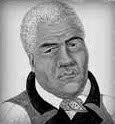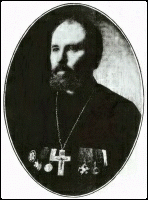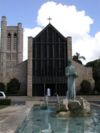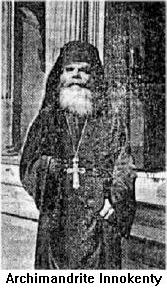Difference between revisions of "Orthodoxy in Hawaii"
(→Rebirth of Orthodoxy) |
(→Rebirth of Orthodoxy) |
||
| Line 17: | Line 17: | ||
=== Rebirth of Orthodoxy === | === Rebirth of Orthodoxy === | ||
| − | [[Image:korchinsky.gif|left|frame|A photo of Fr. Yakov Korchinsky from the Pacific Commercial Advertiser, January 23, 1916]] On [[November 27]], 1910 ([[Julian Calendar]]), with the blessing of the [[bishop]]s of Vladivostok and in America, the first Russian Orthodox reader services were held by Reader Vasily Pasderin. November 27 was, and is, the "Feast Day of the [[Kursk Root Icon]] of the [[Mother of God]]." | + | [[Image:korchinsky.gif|left|frame|A photo of Fr. Yakov Korchinsky from the Pacific Commercial Advertiser, January 23, 1916]] On [[November 27]], 1910 ([[Julian Calendar]]), with the blessing of the [[bishop]]s of Vladivostok and in America, the first Russian Orthodox reader services were held by Reader Vasily Pasderin. November 27 was, and is, the "Feast Day of the [[Kursk Root Icon]] of the [[Mother of God]]." [[Image:episcopal.jpg|right|thumb|100px|St. Andrew's Episcopal as it appears today in downtown Honolulu]] |
In 1915, at the petition of the Russian Orthodox community to the [[Holy Synod]] of the [[Church of Russia|Russian Orthodox Church]], a Russian Orthodox priest was dispatched to Hawaii to pastor the large population of [[Church of Russia|Russian Orthodox]] faithful. On Orthodox Christmas (Dec.25/Jan. 7), Protopresbyter Yakov Korchinsky celebrated the Divine Liturgy at Saint Andrew's Episcopal Cathedral in Honolulu, and he established permanent liturgical services. Thus Orthodoxy was re-established in Hawaii. Fr. Yakov, a well-known [[missionary]] priest, established churches in [[Canada]], the [[United States]], [[Alaska]], and [[Australia]]. He was murdered in [[Odessa]] shortly after the [[October Revolution]] in Russia. | In 1915, at the petition of the Russian Orthodox community to the [[Holy Synod]] of the [[Church of Russia|Russian Orthodox Church]], a Russian Orthodox priest was dispatched to Hawaii to pastor the large population of [[Church of Russia|Russian Orthodox]] faithful. On Orthodox Christmas (Dec.25/Jan. 7), Protopresbyter Yakov Korchinsky celebrated the Divine Liturgy at Saint Andrew's Episcopal Cathedral in Honolulu, and he established permanent liturgical services. Thus Orthodoxy was re-established in Hawaii. Fr. Yakov, a well-known [[missionary]] priest, established churches in [[Canada]], the [[United States]], [[Alaska]], and [[Australia]]. He was murdered in [[Odessa]] shortly after the [[October Revolution]] in Russia. | ||
| − | |||
| − | |||
In subsequent years, the [[Church of Russia|Russian Orthodox]] in [[Hawaii]] shipped or flew priests to Hawaii to care for the dwindling Orthodox population. [[Archimandrite]] Innokenty Dronov of Hilo, a contemporary of St. [[Jonah of Manchuria]] and St. [[John Maximovitch|John of Shanghai and San Francisco]] and Metropolitan [[Meletius of Harbin]], served the entire Orthodox Christian flock on all the [[Hawaii]]an Islands throughout the 1930s and 1940s. [[Image:innokenty.jpg|left|frame|Fr. Innokenty in front of the Old Apostles Episcopal church in Hilo]] Fr. innokenty had a large following of [[Church of Japan|Japanese Orthodox]] Christians. He frequently returned to the [http://www.wadiocese.com Diocese in San Francisco] to report to [[Archbishop Tikhon]] and for medical reasons. He is now purportedly buried on the [[Big Island of Hawaii]]. | In subsequent years, the [[Church of Russia|Russian Orthodox]] in [[Hawaii]] shipped or flew priests to Hawaii to care for the dwindling Orthodox population. [[Archimandrite]] Innokenty Dronov of Hilo, a contemporary of St. [[Jonah of Manchuria]] and St. [[John Maximovitch|John of Shanghai and San Francisco]] and Metropolitan [[Meletius of Harbin]], served the entire Orthodox Christian flock on all the [[Hawaii]]an Islands throughout the 1930s and 1940s. [[Image:innokenty.jpg|left|frame|Fr. Innokenty in front of the Old Apostles Episcopal church in Hilo]] Fr. innokenty had a large following of [[Church of Japan|Japanese Orthodox]] Christians. He frequently returned to the [http://www.wadiocese.com Diocese in San Francisco] to report to [[Archbishop Tikhon]] and for medical reasons. He is now purportedly buried on the [[Big Island of Hawaii]]. | ||
Revision as of 09:33, May 25, 2007
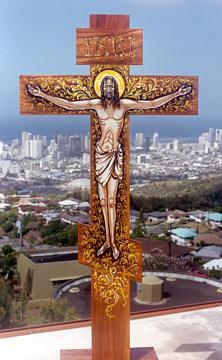
Contents
History of Hawaiian Orthodoxy
Christianity in Hawaii
The first Christian service held in Hawaii was a Russian Orthodox Paschal service. Somewhere between 1792 and 1793, while traveling from Far East to what was then Russian America, a Russian trading ship stopped over in the Hawaiian Islands. The Russian Orthodox priest, not wanting to celebrate Holy Pascha (Easter) at sea, instructed the captain to disembark. The captain then told the priest that he feared the native Hawaiians but was then told, "They will not harm us, for we are Orthodox, and we bear the Light of Christ to illumine their hearts." The priest then landed and blessed a temporary altar under a newly built temple made out of palms and bamboo. As they departed, the Orthodox priest nailed a copy of the miracle-working Znamenny (Kursk-Root) Icon of the Sign of the Mother of God to a bamboo post, promising that, "We shall return and baptize these natives to the One, Holy, Catholic, and Apostolic Church."
First Orthodox Chapels
In 1815, Russians built Hawaii's first Orthodox Church; the Russian Orthodox chapel at Fort Elizabeth. On the Island of Kaua'i, three Russian forts were built: Fort Alexander, Fort Barclay, and Fort Elizabeth. Fort Alexander also housed a small Orthodox chapel, but Fort Elizabeth was the trading base for the new Russian-American Company in Hawaii. When King Kaumuali'i of Kaua'i ceded his kingdom to King Kamehameha the Great in 1816 following the tsar's refusal to annex Kaua'i due to political troubles in Russia, the forts were also ceded, and the Hawaiian Islands become one unified kingdom. The chapels ultimately fell into disrepair after Calvinist missionaries from the United States landed in 1820 after the death of King Kamehameha I.
In 1882, the Hawaiian Kingdom sent a diplomatic delegation to St. Petersburg, Russia, to witness the coronation of Tsar Alexander III. The reports of the Hawaiian special envoy to the Russian court, Colonel Curtis 'Iaukea, about the liturgical services were widely published in Hawaiian-language newspapers. Two years later, Tsar Alexander III sent King Kalakaua the Imperial Order of St. Alexander of Nevsky, the highest Russian award, and established a permanent Russian embassy in Hawaii, along with a very small Orthodox chapel. Subsequently, 200 Ukrainians were imported by American sugar planters.
In 1893, Queen Lili'uokalani was deposed by U.S, Marines and American sugar plantation owners, who were mostly the children of American Calvinist missionaries, and a provisional government under the protection of the United States was installed. In 1898, Hawaii was incorporated into the United States despite near universal opposition from native Hawaiians. In the early 1900s, the Russian ambassador was recalled, the embassy was moved to a small office, and the Russian chapel was closed.
Rebirth of Orthodoxy
On November 27, 1910 (Julian Calendar), with the blessing of the bishops of Vladivostok and in America, the first Russian Orthodox reader services were held by Reader Vasily Pasderin. November 27 was, and is, the "Feast Day of the Kursk Root Icon of the Mother of God."In 1915, at the petition of the Russian Orthodox community to the Holy Synod of the Russian Orthodox Church, a Russian Orthodox priest was dispatched to Hawaii to pastor the large population of Russian Orthodox faithful. On Orthodox Christmas (Dec.25/Jan. 7), Protopresbyter Yakov Korchinsky celebrated the Divine Liturgy at Saint Andrew's Episcopal Cathedral in Honolulu, and he established permanent liturgical services. Thus Orthodoxy was re-established in Hawaii. Fr. Yakov, a well-known missionary priest, established churches in Canada, the United States, Alaska, and Australia. He was murdered in Odessa shortly after the October Revolution in Russia.
In subsequent years, the Russian Orthodox in Hawaii shipped or flew priests to Hawaii to care for the dwindling Orthodox population. Archimandrite Innokenty Dronov of Hilo, a contemporary of St. Jonah of Manchuria and St. John of Shanghai and San Francisco and Metropolitan Meletius of Harbin, served the entire Orthodox Christian flock on all the Hawaiian Islands throughout the 1930s and 1940s. Fr. innokenty had a large following of Japanese Orthodox Christians. He frequently returned to the Diocese in San Francisco to report to Archbishop Tikhon and for medical reasons. He is now purportedly buried on the Big Island of Hawaii.In the 1960s a Greek community established a seperate Greek Orthodox parish under the auspices of the Greek Archdiocese. This community became known as the Saints Constatine and Helen Greek Orthodox Church. Soon thereafter, in the early 1990's, a Serbian community established an Orthodox mission dedicated to Saint Lazar of Kosovo. The Serbian mission later went inactive and joined the local Greek and Russian Orthodox churches. In early 2004 a new Orthodox community under the jurisdiction of the OCA was established in Kona, Hawaii. This new mission has no association with the Russian Orthodox mission established by Archimandrite Innokenty Dronov of Hilo (+1940's).
In the late 1990s, the current pastor of the Russian Orthodox community, Father Anatole Lyovin, one of the first Russian Orthodox priests since Archimandrite Innokenty, was ordained to serve the Orthodox faithful in Hawaii. Currently there are plans to build the first Russian Orthodox church in Honolulu.

